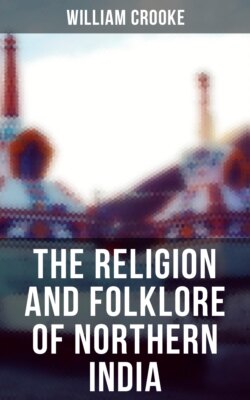Читать книгу The Religion and Folklore of Northern India - William Crooke - Страница 88
На сайте Литреса книга снята с продажи.
Hardaul Lâla, the Cholera Godling.
ОглавлениеTable of Contents
But the great cholera godling of Northern India is Hardaul, Hardaur, Harda, Hardiya or Hardiha Lâla. It is only north of the Jumnâ that he appears to control the plague, and in Bundelkhand, his native home, he seems to have little connection with it. With him we reach a class of godlings quite distinct from nearly all those whom we have been considering. He is one of that numerous class who were in their lifetime actual historical personages, and who from some special cause, in his case from the tragic circumstances of his death, have been elevated to a seat among the hosts of heaven. Hardaur Lâla, or Dîvân Hardaur, was the second son of Bîr Sinha Deva, the miscreant Râja of Orchha, in Bundelkhand, who, at the instigation of Prince Jahângîr, assassinated the accomplished Abul Fazl, the litterateur of the court of Akbar.23 His brother Jhajhâr, or Jhujhâr, Sinh succeeded to the throne on the death of his father; and after some time suspecting Hardaur of undue intimacy with his wife, he compelled her to poison her lover with all his companions at a feast in 1627 A.D.
After this tragedy it happened that the daughter of the Princess Kanjâvatî, sister of Jhajhâr and Hardaur, was about to be married. Her mother, according to the ordinary rule of family etiquette, sent an invitation to Jhajhâr Sinh to attend the wedding. He refused with the mocking taunt that she would be wise to invite her favourite brother Hardaur. Thereupon, she in despair went to his cenotaph and lamented his wretched end. Hardaur from below answered her cries, and promised to attend the wedding and make all the necessary arrangements. The ghost kept his promise, and arranged the marriage ceremony as befitted the honour of his house.
Subsequently he is said to have visited the bedside of the Emperor Akbar at midnight, and besought him to issue an order that platforms should be erected in his name, and honour be paid to him in every village of the Empire, promising that if he were duly propitiated, no wedding should ever be marred with storm or rain, and that no one who before eating presented a share of his meal to him, should ever want for bread. Akbar, it is said, complied with these requests, and since then the ghost of Hardaul has been worshipped in nearly every village in Northern India. But here, as in many of these legends, the chronology is hopeless. Akbar died in 1605 A.D., and the murder of Hardaul is fixed in 1627.
He is chiefly honoured at weddings, and in the month of Baisâkh (May), when the women, particularly those of the lower classes, visit his shrine and eat the offerings presented to him. The shrine is always erected outside the hamlet, and is decorated with flags. On the day but one before the arrival of a wedding procession, the women of the family worship Hardaul, and invite him to the ceremony. If any signs of a storm appear, he is propitiated with songs, one of the best known of which runs thus—
Lâla! Thy shrine is in every hamlet!
Thy name throughout the land!
Lord of the Bundela land!
May God increase thy fame!
Or in the local patois—
Gânwân chauntra,
Lâla desan nâm:
Bundelê des kê Raiya,
Râû kê.
Tumhârî jay rakhê
Bhagwân!
Many of these shrines have a stone figure of the hero represented on horseback, set up at the head or west side of the platform. From his birthplace Hardaul is also known as Bundela, and one of the quarters in Mirzapur, and in the town of Brindaban in the Mathura District, is named after him.24
But while in his native land of Bundelkhand Hardaul is a wedding godling, in about the same rank as Dulha Deo among the Drâvidian tribes, to the north of the Jumnâ it is on his power of influencing epidemics of cholera that his reputation mainly rests. The terrible outbreak of this pestilence, which occurred in the camp of the Governor-General, the Marquess Hastings, during the Pindâri war, was generally attributed by the people to the killing of beef for the use of the British troops in the grove where the ashes of Hardaul repose. Sir C. A. Elliott remarks that he has seen statements in the old official correspondence of 1828 A.D., when we first took possession of Hoshangâbâd, that the district officers were directed to force the village headmen to set up altars to Hardaul Lâla in every village. This was part of the system of “preserving the cultivators,” since it was found that they ran away, if their fears of epidemics were not calmed by the respect paid to the local gods. But in Hoshangâbâd, the worship of Hardaul Lâla has fallen into great neglect in recent times, the repeated recurrence of cholera having shaken the belief in the potency of his influence over the disease.25
